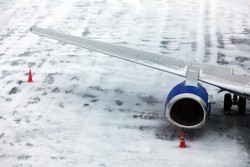Self-heating protection technology to prevent ice buildup on wings
Icing is a major challenge affecting the aviation industry and can lead to delays, stoppages and cancellations during severe weather conditions. To help reduce the likelihood of ice forming on aircraft wings, which can affect an aeroplane's ability to take off and land, the EU-funded SONEWIPS (Sonaca contribution to an electro-thermal wing ice protection system) project worked to develop a self-heating wing to avoid ice buildup. Project partners developed an Airbus A320 slat demonstrator equipped with an electric wing-ice protection system (eWIPS). Work began by defining the eWIPS operational requirements. Using the requirements as a basis, they performed technological developments to assess innovative solutions that comply with performance specifications. The members also integrated electrical components in a hybrid layup by using advanced composite and metallic materials. Icing wind tunnel tests successfully validated eWIPS efficiency in terms of wing-ice protection, heating configuration and system control strategy. To simplify system architecture and improve reliability, the SONEWIPS team optimised the eWIPS concept. For this purpose, it considered three different options for simplified system architecture based on configurations that require significantly less system components. Researchers successfully validated the thermal performance for the three developed operating modes during icing wind tunnel tests. Trials showed that significantly reducing system components resulted in enhanced ice protection performance. A more robust and reliable system should lead to reduced costs. By validating an efficient and effective eWIPS system, SONEWIPS technology will one day be integrated into transport aircrafts' leading-edge systems and structures.







